Looming over the town of La Fortuna, Arenal Volcano is one of Costa Rica’s five active volcanoes. Originally thought to be dormant, this volcano unexpectedly sprang to life in 1968. For 15 days, the mighty Arenal showed the world it was very much alive, spewing lava, rocks, and ash over 15 square kilometers. That catastrophic eruption, which killed 73 people and buried three towns, was Arenal’s biggest. Since then, Arenal has had smaller eruptions, though its activity has slowed considerably since 2010. Today, you may not see the famed orange glow of lava illuminating the night sky, but the cone-shaped giant is still a spectacular sight. In this post, we cover what you need to know to hike the two sectors of Arenal Volcano National Park. We include information on the new La Peninsula sector as well as how to book a good guide.
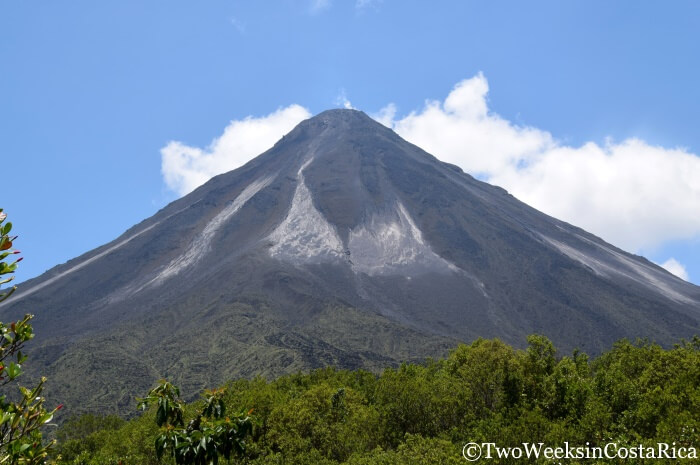
Overview
The 12,080 hectare (29,850 acre) Arenal Volcano National Park has more to offer than just a view of the volcano. The park has easy-to-navigate trails through secondary forest and former lava fields. The most well-known trails with the best volcano views are at the main sector. Now, as of 2017, there is another sector to explore. La Peninsula, with gorgeous views of Lake Arenal, recently opened and is a wonderful spot for young children and those with limited mobility due to its paved trails. We will cover both sectors below.
Here is a link to the trail map.
Main Sector of Arenal Volcano National Park
Trails
We have hiked the park from this sector a few times and have always enjoyed it. It has two main trails, which form a nice loop. We recommend doing the whole loop (4 km or 2.5 miles) so that you see the major points of interest. After you pass through the ranger station and pay your entrance fee, you can keep driving past the first parking area to another parking area closer to the trailhead for Sendero Las Coladas.
Sendero Las Coladas means the Flows Trail, and this 1.7 km (1 mile) stretch marks the location of the old lava flows from the eruption of 1992. A short distance into this trail is an intersection with Sendero La Ceiba. On our last visit, our guide recommend taking La Ceiba and then looping back to Las Coladas after so that we ended at the viewpoint for the volcano. Both trails are fairly flat, with the exception of the climb up to the lava flows and viewpoint (more on this below).
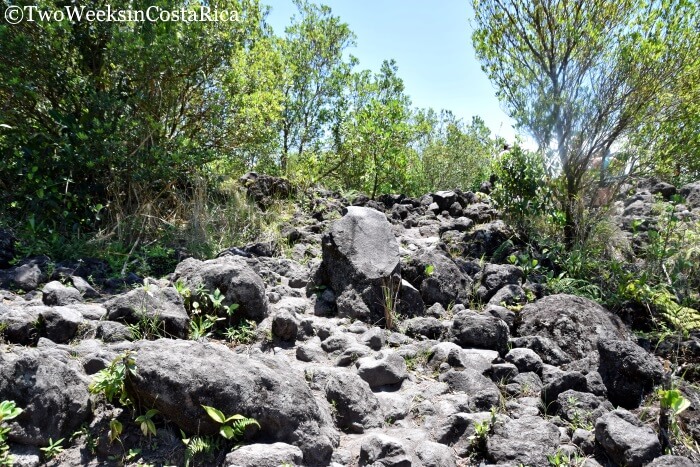
As you walk, you will be able to see how the forest has recovered from prior eruptions. Towering sugarcane turns to thick rainforest with epiphytes, vines, and bromeliads dangling from limbs. Although much of this is secondary growth as most plants and trees were destroyed, miraculously, some things managed to survive. Of note are four large fig trees and a giant Ceiba tree. It is thought that volcanic gases and heat rushing down the volcano during the eruption jumped over these lucky trees thanks to a small hill in the way.
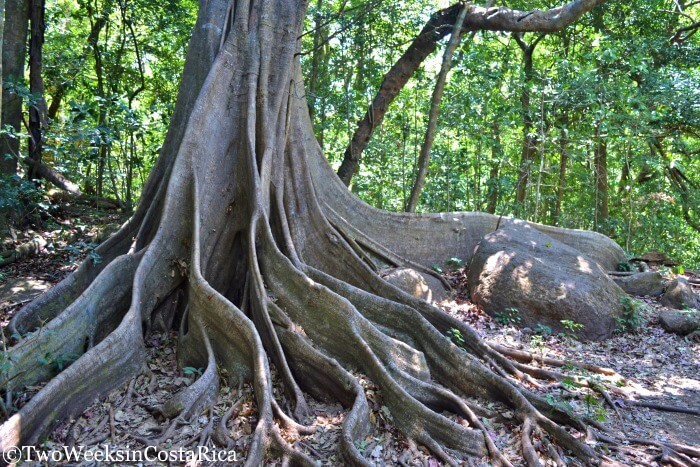
Continuing on to the main attraction, the forested trail ends and leads to the lava flows. Here, you can walk on the decades-old volcanic rocks to enjoy a fantastic view of the volcano. To reach the mirador, you have to climb a short, but steep, set of rustic stairs. This leads to a field of black volcanic rock (pictured above), and finally, a close up of Arenal Volcano.
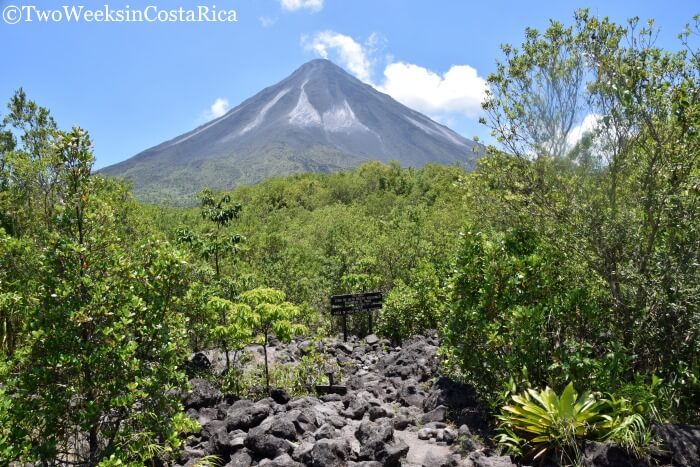
From the lookout, in one direction you can see the western side of the volcano. In the other direction, you can see beautiful Lake Arenal.
Wildlife
Although this park is known primarily for its fascinating geological history, you can also see a fair amount of wildlife. On our visits, we have seen white faced capuchin monkeys, coati (a raccoon-like animal), Great Curassow (pheasant-like birds), green basilisk lizards, bats, and a variety of insects, including a wolf spider.
Arenal Volcano National Park is especially known for birds because of its varied habitat. The rare Bare-necked Umbrellabird and Three-wattled Bellbird can be spotted here. On our most recent visit, with the help of our fantastic guide, we were able to see the Common Potoo for the first time, which was very exciting. These are somewhat rare and are extremely difficult to spot by design. They are often found perched at the top of a dead tree but are gray and blend in almost perfectly to their surroundings.
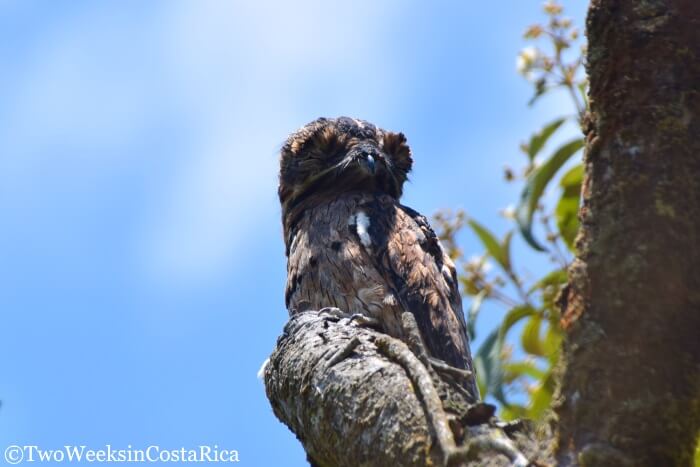
La Peninsula Sector of Arenal Volcano National Park
La Peninsula Sector is a separate ranger station and the newest addition to the park. To reach it, drive past the main entrance and take a sharp right at the first fork, almost like you are reversing direction. The ranger station is a few minutes down the bumpy dirt road.
Trails
We were so happy to see La Peninsula opened. Costa Rica has few handicap-accessible trails so this one is a great addition. The trail is a 1.3 km (0.8 mile) stretch, with a short side trail off the main one, which loops out into thick forest. Although the trail is paved, it is narrow and feels immersed in the jungle. We had our son with us, who was 1.5 years old at the time, and this was the perfect hike for him.
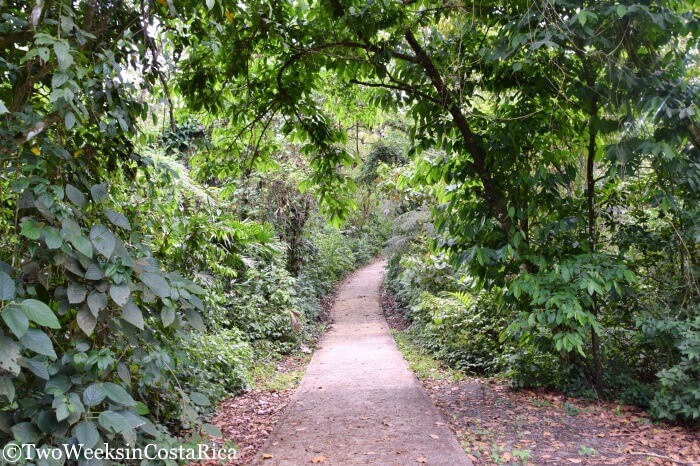
From the ranger station, the trail leads to various lookouts to Lake Arenal and its small islands that peer out of the water. About halfway through, you come to a lofty viewing tower. A climb up the few sets of metal stairs to the top will earn you a nice view of the lake and Arenal Volcano. The volcano view is farther than from at the main sector but still very nice.

Continuing on, the trail keeps going gradually downhill and leads to the shores of the lake. There’s a nice area here right over the water for taking pictures and you can rest on a bench under the shade of a tree.

Wildlife
In the short time we spent at La Peninsula, we saw quite a bit of wildlife. Because this trail doesn’t see too many visitors, birds and animals can be easier to spot. We came across a Great Curassow waddling across the trail, as well as a Keel-billed Toucan (the toucan species with the brightly colored beak). The highlight was definitely the small group of collared peccaries (wild boar-type animals) that we snuck up on coming down the trail near the lake.
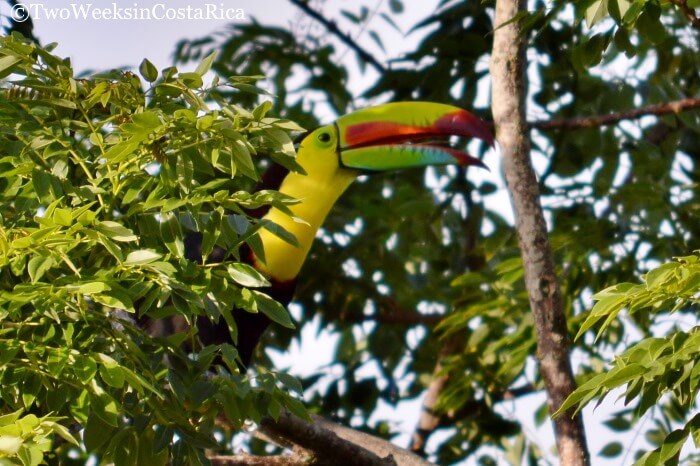
Park Information
Cost
Foreigners: $15 adults, $5 children ages 6-12, free for children 6 and under.
Nationals and residents: ₡1,000 colones.
Hours
Open 8:00 a.m. to 4:00 p.m. Last admission: 2:30 p.m.
Information on Booking a Guided Tour of Arenal Volcano National Park
Arenal Volcano National Park can be done self-guided. Just get a trail map from the ranger station when you check in and follow the well-maintained trails. However, we recommend a guide to learn about the history of the volcano since there is no visitors’ center or information along the trail. The guide that we went out with on our recent visit was a local who knew so much about the history and geology of the volcano and also about the birds and animals we saw. If you would like to book a guided tour with this company, we would be happy to help you with the arrangements. Here is some more information about the tour and how to book:
Cost
Group Tour (12 people max): $68 per adult, $34 per child ages 4-11, free for children 3 and under.
Private Tour (only your family/group): $129 per adult, $65 per child ages 4-11, free for children 3 and under.
Included
Round-trip transportation from your hotel, bilingual naturalist guide, entrance fee, and water.
Times Offered
8:00 – 11:00 a.m. only
Duration
3 hours (approximate)
How to Book
Contact us through our Tour Booking Service page or send us an email at bookings(at)twoweeksincostarica(dot)com with your preferred date and time, the number of people in your party, and your hotel if you would like the included transportation. Booking through us costs the same and helps support our website!
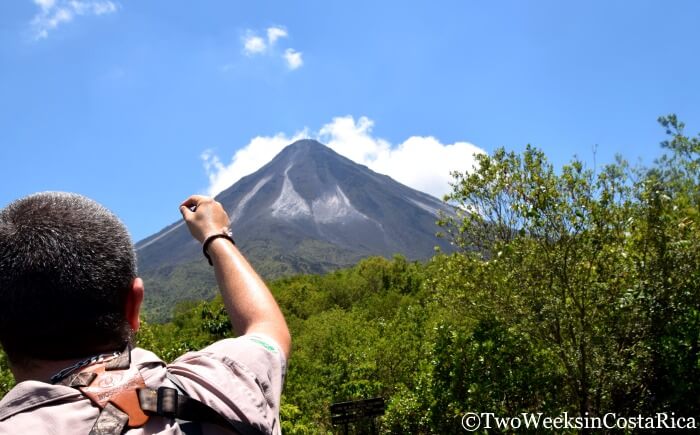
Arenal Volcano is a must-see attraction for those journeying to the highlands of Costa Rica. Although the volcano can be seen all around town, it is truly fascinating to be able to walk the hardened lava flows and see the mighty volcano close up.
Last Updated: December 26, 2019
Have you hiked around Arenal Volcano? What did you think? Let us know in the comments below.
Looking for more information to plan your visit to La Fortuna/Arenal Volcano? Check out these posts:
La Fortuna: What to Expect from Costa Rica’s Most Popular Destination – Our destination guide for enjoying everything La Fortuna has to offer. Includes activity and restaurant recommendations.
La Fortuna Hotel Guide – Read our recommendations for the best places to stay for hot springs and volcano views.
Monteverde: A Forest in the Clouds – If you’re pairing a visit to the volcano with time in the cloud forests of Monteverde, you’ll want to read this post.

